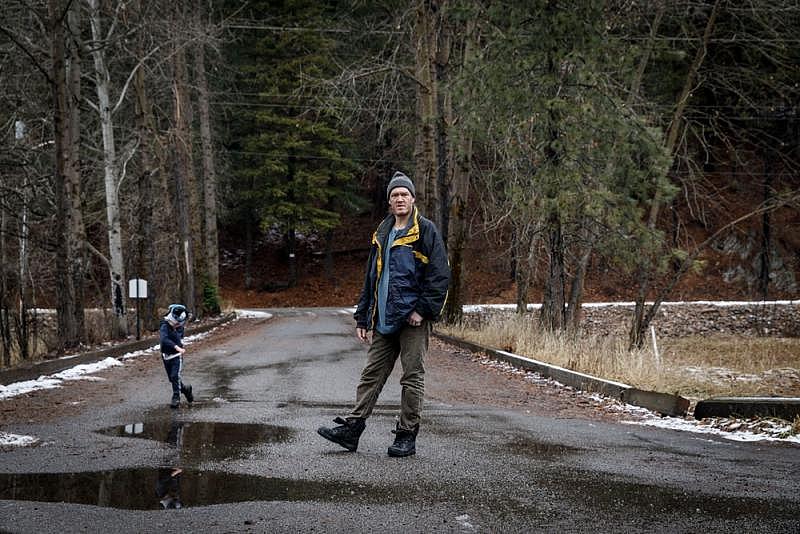Reporter reveals a broken oversight system leading to poisoned children

Floyd Kimball and his 4-year-old son Steve in Wallace, Idaho.
(Photo by Rebecca Stumpf)
A few months back, I cold called the point person overseeing cleanup of Bunker Hill in northern Idaho, one of the nation’s largest Superfund sites. I was poking around for details about remediation at a group of low-income housing complexes built near the site, which was once home to the largest zinc and lead mining and smelting operation in the country. The consequences of people living around Bunker Hill came into focus in 1976 when a smelter fire caused the largest lead poisoning event of children in U.S. history. The mean blood lead level of children living nearest to the smelter at the time was 68 micrograms per deciliter — more than 13 times the current safety threshold (though there is no safe level of lead when it comes to childhood exposure).
But according to the state officials charged with the cleanup, the site was a national model for environmental remediation. In other words, he said, nothing to see here, good luck with your investigation on contaminated subsidized housing.
Ever since it was revealed, in 2016, that a subsidized housing complex was built on a smelter in East Chicago, Indiana, I wanted to know how many other similar health crises were hiding in plain sight. In the wake of the East Chicago discovery, the EPA declared that 70% of Superfund sites across the country are in close proximity to low-income housing. I mapped the data and gathered additional information through FOIA requests, but when I started zeroing in on places like Bunker Hill, there was little evidence to prove that problems persisted. Lead screening among local children, for example, was so limited that the health department didn’t even have data to share in some recent years.
What I found was a broken oversight system where the U.S. Department of Housing and Urban Development was improperly exempting housing authorities from doing environmental assessments. Meanwhile, the U.S. Environmental Protection Agency typically only investigates when alerted that people are being harmed.
I had a hunch that the health department’s rosy assessment wasn’t the whole story, so we kept digging. Through FOIA, I collected hundreds of documents that showed that there was indeed toxic waste, lead and carcinogens buried within the soil of housing complexes near Bunker Hill — and across the country. They suggested that the problems were resolved, or that more testing should be done but never was. With the help of the USC Center for Health Journalism National Fellowship, we were able to prove that people who lived in these properties were being deceived. We hired contractors to collect samples of lead dust in a handful of apartments around the Bunker Hill site. The results confirmed the presence of lead in house dust — the best predictor of blood lead levels in children — at each of the complexes. We met a 4-year-old that lived in one of those apartments that was so severely poisoned by lead, he still couldn’t speak.
There are hundreds of sites across the country that fall within similarly close proximity to apartments and townhomes occupied by some of the nation’s most vulnerable children and families. What I found was a broken oversight system where the U.S. Department of Housing and Urban Development was improperly exempting housing authorities from doing environmental assessments. Meanwhile, the U.S. Environmental Protection Agency typically only investigates when alerted that people are being harmed. In my FOIA work, I connected with dozens of housing authority officials who had no idea that their properties sit in the footprint of a Superfund site. And tenants were in the dark too, moving their families into communities where their children were exposed to lead, carcinogens and other pollutants. In other words, this was one of those rare investigations where officials — from the federal government all the way down to the smallest local agencies — didn’t know much about the problem. Our story was revelatory as a result.
If I have one piece of advice to pass along to the next round of fellows and other reporters out there, it’s to not be afraid to put yourself out there and collaborate. When I was organizing the lead testing in Idaho, for example, I spoke with a past fellow who’d done similar work. I modeled my own testing protocol and sampling log on hers. Also, while in the muck of this investigation, I crossed paths with an intrepid reporter from The Intercept who was trying to piece together the story as well. While I’d already put a ton of work into this project, I knew that together we would break more ground. It was a particularly great match because we each approached the story from different angles. I put out FOIAs to nearly 200 housing authorities across the country to build a site-specific database, and was poring over Sanborn maps and Google Earth to understand the landscape at these properties. My partner took a different approach, starting with people organizing around environmental justice. Together, we closed the knowledge gap about these sites and were able to establish a pattern where thousands of people are left exposed to health risks because of the lack of oversight. Since the article came out, our reporting has gotten some national attention that, hopefully, will turn into action.
Given the way the regulatory oversight system is currently set up, there is no doubt that children and families continue to be exposed to a variety of toxic pollutants in the ground, air and water. And they have no idea about the risks they face.
**

